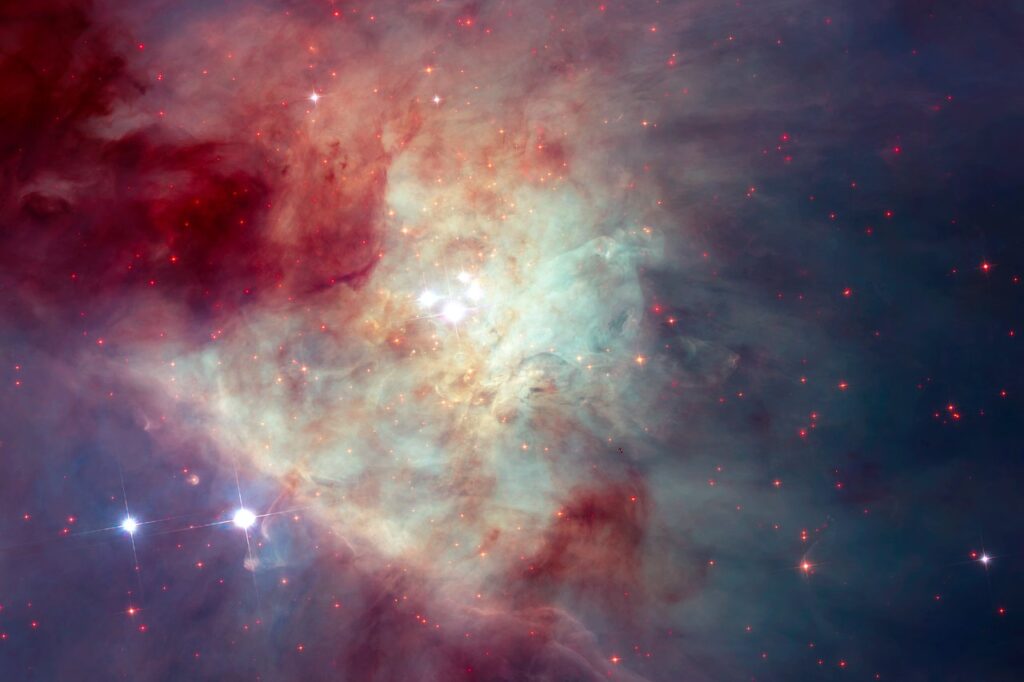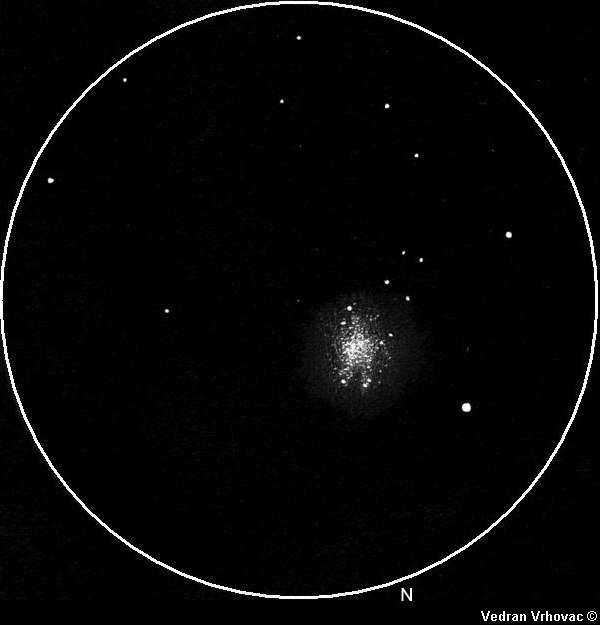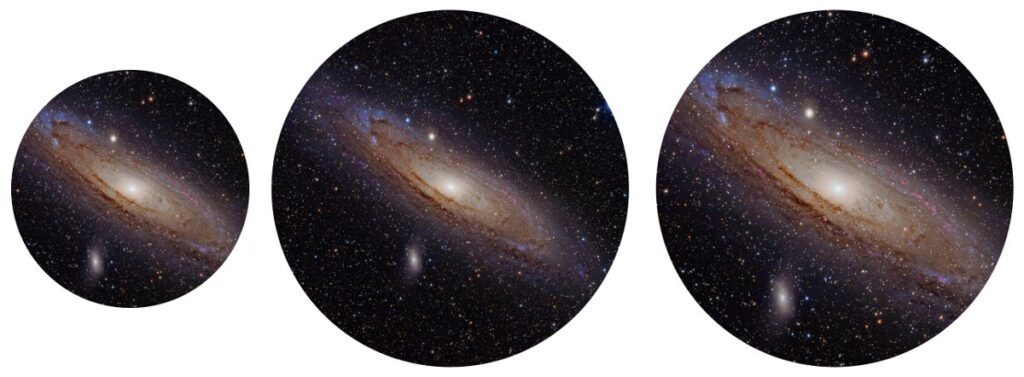Are you considering buying a telescope? Or have you just bought one and are you curious what you can see with it? In this article I zoom in on what you can expect from stargazing with a telescope.
A telescope is a fantastic instrument. It opens up a whole new world, a world full of discovery and observing pleasure. It’s good to know in advance what to expect. In this way you ensure that you can get the most out of your observing experiences. You also prevent disappointments due to (too) high expectations.
Key points
- If you want to google what you can see with a telescope, look for sketches rather than photos
- When observing visually, you hardly see colours, and much less details than you see on photos
- The maximum achievable magnification is in practice about 200 to 250x, so planets always remain small discs
- Good, detailed observing is a skill, take your time!
Watch out googling
If you have bought a telescope, or are considering buying one, you’re of course tempted to search the web to find out what can be seen in the universe. You’ll come across colourful images of nebulae, detailed images of the spiral arms of galaxies, and star clusters with thousands of stars. But beware, this is not what you see when you look through a telescope!

The photos you’ll find, including those created by amateurs, consist of long exposed and combined shots and are heavily edited. Telescope manufacturers – unfortunately – often participate in creating false expectations by printing such pictures on boxes of telescopes.
Want to get a better idea of what your observing targets look like visually through a telescope? Then look for sketches of these objects. There are many observers who like to make drawings of what they see while stargazing and post their results on the internet. This gives you a much better impression of what an object looks like with your own eyes. Often these drawings also mention what kind of telescope and what magnification is used to view the object. This is extremely useful information for estimating what you can expect to see with your own telescope.
It is good to keep in mind that these sketches are often made by experienced observers who have taken ample time to study the object. So you may not be able to see that much structure or detail at a first glance, but that will come naturally as you build experience.

Seeing colours
Our eyes are fantastic tools, but they work especially well during the day. Under dark conditions, the ‘rods’ in our eyes are particularly active. They are very sensitive to light and therefore ensure that we can still see something in low light. But rods cannot distinguish colour and you can also see less details with them than in using your daylight vision.
We therefore see our observing targets through a telescope in shades of gray and a little grainy. You can only see colours in the brightest objects: stars, planets and some planetary nebulae.
Magnification
Each telescope has a maximum magnification. This value depends on the diameter of the aperture of the telescope: the larger this aperture, the more you can magnify. In practice, this is a theoretical value that you will never achieve in practice. Why is that?
It has everything to do with our atmosphere. To observe objects in the universe, you have to look through a thick layer of air, the Earth’s atmosphere. And that air isn’t stable: different layers of air cause swirls, turbulence and other movements that blur the image.
If you magnify a lot with a telescope you will notice this turbulence. Planets and details on the moon are usually a bit blurry and it looks like there is a moving layer of water in front of them. Stars can sometimes look like a disco ball: a bouncing point of light in all the colours of the rainbow. It is not the star itself that twinkles and changes colour, the effect is created because the light from the star is deflected by our atmosphere. Magnifying further does not make much sense, because that only increases the blurriness of the image.

In practice you can observe under normal circumstances with a magnification of up to about 200 to 250x . If the atmosphere is very calm, you might reach 300x, but much higher is rare. So forget the advertising texts on telescope boxes that you can achieve 500x magnification or even higher, theoretically that is correct, but you’ll never reach that in practice!
Galaxies and nebulae are best seen at a somewhat lower magnification
Fortunately, for many objects in the night sky you do not need a high magnification at all. Galaxies and nebulae are best seen at a somewhat lower magnification. So don’t be distracted by swirling advertising texts, and choose the magnification that best suits your observing purpose or the circumstances.
Take your time
Observing with a telescope is a skill that you must learn. It takes a while, but you will notice that you get better and better, and can see smaller and smaller details or dimmer objects. If you have found an observing target, it is worth taking the time to study it closely. Make sure you sit well, relax, and let the object work on you calmly. You will notice that after a while there is much more to see than what you saw at first sight!
Observing targets
You can view different types of celestial bodies with a telescope. Here are some tips per category to help you observe them with a telescope.
Stars
The term ‘stargazing’ is actually a bit confusing, because you won’t really look at the stars themselves with a telescope. Stars are so far away that they remain points of light even with the largest telescopes. You never see the surface of a star. So they are, at least to observe with a telescope, actually a bit boring.
The most beautiful double stars are the ones where the individual stars have a contrasting colour
An exception is the binary star category. These are stars that are close together as seen from Earth. That could be because they really belong together and orbit around each other, or because they seem to be close to each other from our perspective. The most beautiful double stars are the ones where the individual stars have a contrasting colour. A wonderful example of this is the star Albireo, in the Cygnus constellation. This is a bright orange star with a small blue star right next to it. You can already see this pair with a magnification of about 30x.

The Moon
Our Moon is a fantastic observing target. You can see most details on the transition from light to dark on the Moon’s surface. This is called the terminator. Here, the shadows are longest and therefore the surface details on the moon are best visible. With a reasonable magnification, you can see craters and lunar mountains, for example. It pays to take a look every day, because the terminator moves a bit every day, so you can see other details on the moon. The moon always has something beautiful to offer!

Planets
Planets always will be (very) small disks with a terrestrial telescope: they never fill the entire field of view, as you often see in pictures. So if you want to see details on planets, the trick is to learn to spot small, subtle differences on those tiny disks, rather than trying to magnify more.
Planets are rewarding observing targets: because they are so bright, they do not suffer from light pollution. So you can easily observe them from the city!

The distances are not to scale! (CactiStaccingCrane)
Jupiter is often the planet with the largest disk as seen from Earth. With a small telescope you can already clearly see cloud belts on the planet, and four of its moons that orbit on either side of Jupiter. Well-known details on Jupiter, such as the Great Red Spot, are remarkably tricky to find! Keep in mind that reflecting telescopes invert the image: the red spot is therefore located near the top instead of near the bottom of the planetary disk.
With a small telescope you can already clearly see cloud belts on the planet
Saturn is of course best known for its rings! You can already see them with a magnification of about 25 to 30x: a spectacular and unforgettable sight. Furthermore, not a lot of surface details are visible on Saturn. Titan is its brightest moon, which can usually be seen with a small telescope if it is at a considerable distance from the planet. With somewhat larger telescopes you can see four or five other moons.

Venus is closer to the sun than Earth, so the planet is only visible in the morning or evening sky — never in the middle of the night. He (or she?) has phases, just like the moon: Venus therefore looks like a sickle, a ‘crescent moon’. You can already observe this with a magnification of about 50x.
Mars can get pretty big when it’s close to Earth, but seeing surface details on the red planet can be a bit of a challenge, as they’re often a little hard to discern. You may be able to see dark spots on the surface or the white ice caps in the polar regions. Sometimes dust storms rage on Mars, which then obscure all surface details.

Mercury , Uranus and Neptune are so small as seen from Earth that they never grow larger with a telescope than a tiny disk with no detail visible. With Uranus and Neptune the colour is striking (the first is a bit greenish, the second blue in colour). Because Mercury, like Venus, is closer to the sun than Earth, it can only be seen in the morning or evening. When the planet is visible, it is always close to the horizon, requiring you to peek through a thick layer of the atmosphere. This makes observing this planet with a telescope fairly difficult.
Star clusters, galaxies and nebulae
This category of celestial objects is referred to by the somewhat confusing term ‘deep-sky objects’. With a small telescope, most of them look similar: a faint, misty patch of light, sometimes barely distinguishable from the sky background.
That doesn’t sound spectacular, but you’ll find that the more experience you build up, the more detail you’ll be able to see. You may be able to see some structure in the Orion Nebula (Messier 42), get a hint of the spiral arms of Messier 51, or make out some individual stars on the edges of globular clusters like Messier 13.
The more experience you build, the more details you’ll be able see
With a telescope, some star clusters can be resolved into dozens or hundreds of individual stars, which are twinkling in the field of view. A beautiful sight! Try it with bright star clusters like Messier 35, Messier 39 or Messier 44.
A good dark sky makes a huge difference with this category of objects. The darker the background of the night sky, the more contrast the object has against that background and the easier it is to see. So it pays to get out of town and look for a nice observing spot far away from the city lights.
Have fun observing!
I hope this article has given you a good idea of what to expect when stargazing with a telescope. Enjoy, and let me know what you’ saw’ve observed! Don’t have a telescope yet? Have a look here for suggestions!
Do you want to stay on top of events in the night sky? Follow Waddensky on Instagram or Twitter or download our app Nightshift!